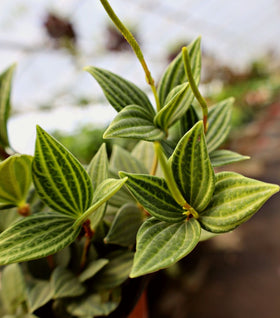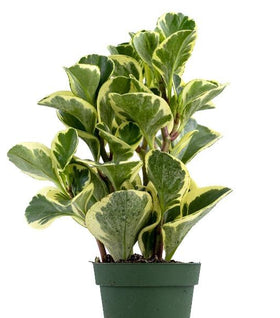Peperomia Plants for Sale Online
Peperomias are enjoying a resurgence in popularity due, in most part, to the easy-going nature. Peperomias are easy to grow and easy to care for, even the most inexperienced plant parent. If you have always wanted to grow houseplants but have been a little worried, peperomias will build your confidence and prepare you to jump headfirst into the exciting world of indoor plants.
Peperomias are the perfect size for using as a desk plant, table-top plant, or even to tuck into the smaller spaces in your house plant collection. Not true succulent plants; they are very similar in all aspects—the sport fleshy, colorful leaves. Native to South America's rainforests, they are adapted to growing in the loamy soil in dappled sunlight.
Care Instructions for Peperomia House Plants
Light Requirements for Peperomias:
peperomia prefer medium to bright light. Place peperomia near a window that gets morning sun. Artificial light is also acceptable, making them great for a desktop in the office. Proper amounts of sunlight or artificial light will bring out the best of these colorful leaves.
Best Soil for Peperomia Plants:
Many peperomias are epiphytic in the wild, meaning they grow on trees and other plants, absorbing water and nutrients from decaying bark. This is a similar growing condition to orchids. When choosing a potting soil for your peperomia, choose soil with large chunky particles. You may use regular potting soil, but we suggest you mix the soil with equal parts of orchid bark and perlite.
Watering Peperomias:
Having leaves similar to succulent plants means that the peperomia will not need frequent watering to remain healthy and vigorous. If you often forget to water your indoor plants, peperomias are among the few plants that will thank you for this.
Keep your peperomia on the dry side to keep it in its healthiest condition. Keeping your plant constantly wet will cause rot root and could lead to the death of your new plant buddy. Do not allow your peperomia to sit in a saucer of water. The best way to water is to take the plant to the sink for water and allow it to drain before returning it to its home.
Temperature and Humidity:
Peperomia plants are native to tropical regions and therefore like to be warm and prefer humid environments. It may be necessary to place your plant on a saucer full of pebbles and water during the winter months. The water level should never be filled all the way to the bottom of the pot but just below the surface of the pebbles. This will keep the ambient humidity around the plant at the optimal level.
Feeding Peperomia Plants:
Peperomias are not heavy feeders meaning it is unnecessary to feed these plants too often. Being epiphytic, they are conditioned to absorb nutrients from their surroundings efficiently. Feeding one time in the spring and again in the summer is more than enough for these jewels of the tropics.
If you begin to notice the plants beginning to lose their vigor and take on a light green color, this is more often caused by over-watering or poor light than a lack of nutrients.
Repotting Peperomia Plants:
Peperomias can live in very small pots for many years without the need for re-potting. They do not mind becoming "root-bound" coupled with their slow growth habit; there is very little need for re-potting. If reporting becomes necessary, be sure to choose a pot with large drainage holes.
Peperomias grown in Orchid Pots:
Some house plant growers prefer to grow their peperomias in orchid pots. Orchid pots have very large openings that allow for good aeration. This will help to establish a healthy root system and promote healthy growth for many years. If you choose to try the orchid pot method, be sure to use orchid bark as your potting medium as regular soil will fall out of the large openings.






